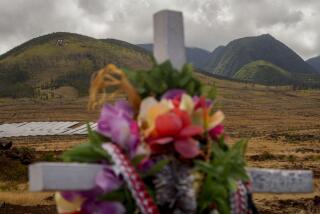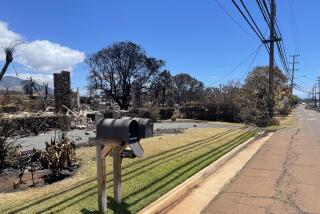Plans in Ashes : Upset Mother Made Appointments as End Approached
- Share via
In the days before Easter Sunday--when she is believed by police to have set fire to her Anaheim home, killing herself and her two young daughters--Mitsue Sakai was busily making plans for the future, friends and acquaintances said Monday.
The Japanese-born woman had arranged to have her 4-year-old, Rina Stephanie, placed next fall in the kindergarten class that her 5-year-old, Seira Candy, was attending this year. And she had made an appointment for Monday afternoon to meet with Seira’s teacher, as part of her school’s parent-teachers conference this week.
Arranged for Baby Sitter
Only hours before the early-morning fire, Sakai telephoned her baby sitter and completed Easter Day arrangements for her daughters; she was scheduled to work at her job as a waitress at a nearby Japanese restaurant.
When she left work Saturday night, friend and co-worker Kazuko Inoue said Sakai nonchalantly told the others: “Goodby, I’ll see you all tomorrow.”
However, Anaheim police investigating the three deaths said they have determined that Sakai, 28, was indeed troubled Saturday night.
Immediately before the fire she is believed to have set in her living room at 12:45 a.m. Sunday, a “very distraught” Sakai telephoned two friends and confided to them that she was having marital problems, said Anaheim Police Sgt. John Kolbo, who refused to elaborate on the nature of the problems.
An hour earlier, Sakai had tried and failed to reach her husband, Hideo, at his job as head chef at the Amagi restaurant in Buena Park, according to the owner, Yoshikazu Suzuki. Hideo Sakai had left work about 11 p.m. Saturday, Suzuki said. Neighbors said he did not return home until 2:30 a.m., after the fire had been extinguished.
Kolbo said that while her daughters slept in a rear bedroom of the family’s home on West Harriet Lane, Sakai piled papers in the living room and set them afire. She then joined her daughters in the bedroom, where all the windows were closed, and the three soon died of smoke inhalation, he said. Fire gutted the single-story tract home.
The deaths appeared to involve the Japanese phenomenon of oyako-shinju , in which parent-child suicide is considered an honorable way of dying in the face of financial problems stemming from a failed marriage, said Dr. Mamoru Iga, professor emeritus in sociology at Cal State Northridge and author of a book on the subject. The act is most commonly committed by women who take their children with them so they will not be left orphans, Iga said.
“There is a strong prejudice (in Japan) against orphans without parental protection,” Iga said Monday.
Although the act is illegal in Japan, oyaku-shinju lingers in the culture, and offenders rarely are prosecuted, Iga said. Oyaku-shinju is comparatively rare in the United States, where a better welfare system exists to support single parents, Iga said.
In 1985, a Japanese-born woman walked into the Santa Monica surf with her two small children because of her husband’s relationship with another woman. The woman, Fumiko Kimura, survived, but her two children, a son, 4, and a 6-month-old daughter, drowned. Kimura pleaded guilty to voluntary manslaughter in November, 1985. She was sentenced to five years’ probation and given credit for serving 297 days in jail.
In Sakai’s case, however, close friends and associates on Monday professed disbelief that she would have cause to commit oyaku-shinju. Mitsuko Kawamoto, a friend as well as her baby sitter, said Sakai telephoned her three times late Saturday night and never related that she was upset. All Sakai talked about was Kawamoto’s plans to take care of Sakai’s daughters the next day for Easter, said Kawamoto, a close friend for the past seven years.
“If she had a complaint, she would have told me, and she didn’t,” Kawamoto said. “She was like my sister.”
Inoue, a co-worker with Sakai at the Mitsuyoshi Japanese restaurant in Anaheim, said she worked the dinner shift with Sakai Saturday night and that she did not seem upset.
“I never believe it was suicide,” added Inoue, who lives across the street from Sakai.
Kawamoto said she cared for the Sakai children at her Anaheim residence until their mother got off work at 10:30 p.m. Saturday and picked them up. She said she fed them a dinner of roast beef that night, and that earlier in the day they played with Inoue’s 8-year-old daughter.
Sakai’s children also played with some Cambodian children who lived on the street. Sea Han, 38, said his children--Bee, 5, Sprey, 4, and Duke, 12--all played with the Sakai girls nearly every day.
“My son (Duke) didn’t sleep last night,” Sea Han said Monday. “He’s still scared about what happened.”
At the nearby Dr. Jonas E. Salk School, where Seira attended kindergarten, principal Dan W. Copple said the deaths came as a special shock because the girls’ mother had taken so much interest in the education of her daughters.
He said that Sakai enrolled her oldest daughter in the school last September and indicated a week and a half ago that she planned to enroll her other daughter in kindergarten classes this fall. Copple said the mother was especially pleased to have a woman of Japanese heritage teaching her Japanese-speaking daughters.
The teacher, Shirley Enomoto, said the mother was so concerned about Seira’s education that she arranged to get the lessons when Sakai’s father died in November and she returned with the children to Japan for three months. Sakai’s husband remained in Anaheim during that time, neighbors said.
When she returned in February, Enomoto said Sakai rushed to the school to make sure Seira could remain in the kindergarten classes. Since the child had kept up in her independent studies, Enomoto agreed. Enomoto said the mother was also in school frequently consulting on her daughter’s difficulty in speaking English, a problem which she said handicapped the child her in classes.
Before Easter vacation for the school’s 780 students began last week, Enomoto said she had invited Sakai to a 2:20 p.m. appointment Monday for parent-teachers week. Enomoto said Sakai sent back a written reply promising to be there.
The only unusual thing Enomoto recalled about the Sakai family was Seira’s response on the last Friday before Easter vacation to a question about what all the students would be doing for Easter.
“Seira said she was going to go back to Japan with her mother,” Enomoto said, wrinkling her brow in puzzlement. “I told her that she had already been to Japan.”
Claude Corwell, 56, a neighbor, said he also noticed a change in Sakai’s behavior after her return from Japan.
“Before, she was always friendly. After, she didn’t pay any attention to us,” Corwell said.
Corwell said he had a sneaking suspicion all was not well in the Sakai household, as the couple “did not seem that close. They didn’t go out together.”
Corwell spoke as he tended to his yard directly across from the Sakais’ home, which lay vacant and charred Monday afternoon with yellow police tape still cordoning off the property. Several bouquets of flowers lay beneath a large pepper tree, deposited by tearful well-wishers.
“One lady came by (Monday) and just stood by the tape and cried,” Corwell said. “It’s a sad affair.”
Sakai’s husband reportedly was staying with other friends Monday and could not be reached for comment. Services for Sakai and her two children are pending the arrival of her mother from Japan later this week.
More to Read
Sign up for Essential California
The most important California stories and recommendations in your inbox every morning.
You may occasionally receive promotional content from the Los Angeles Times.










